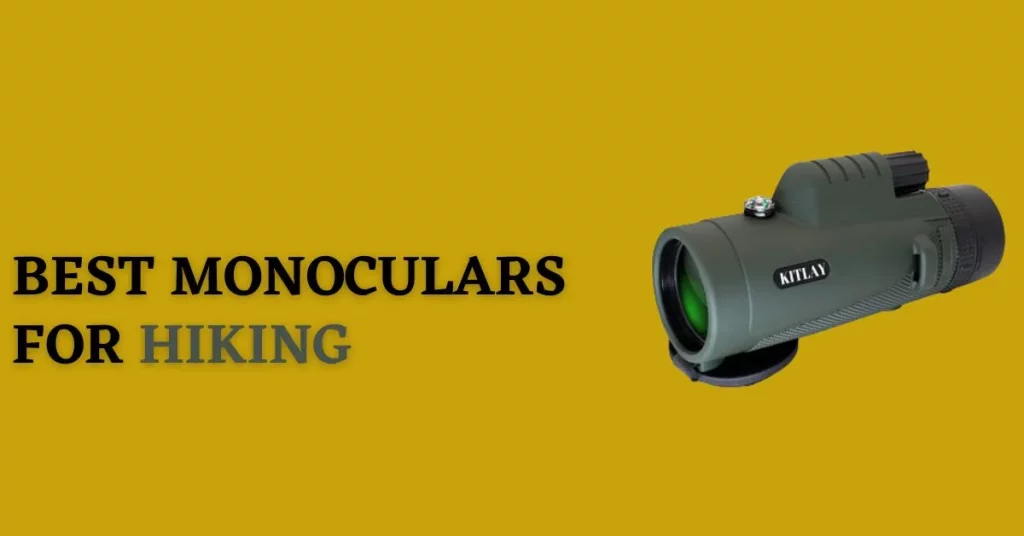A monocular is a compact and lightweight optical device. That provides a clear and magnified view of distant objects. It is a handy alternative to binoculars, especially for hikers. Who wants to reduce the weight of their gear while still enjoying a close-up view of the landscape? That’s why having the best monoculars for hiking is essential for nature enthusiasts, birdwatchers, hunters, and outdoor adventurers.
The right hiking monocular should be waterproof, fog-proof, and shock-resistant to withstand harsh weather and rugged terrain. With the proper monocular, hikers can spot wildlife, admire scenic vistas, and confidently navigate their path.
Here is the list of our top-picked monoculars for hiking.
- Leica Monovid 8×20 Monocular
- Bushnell Legend Ultra HD Monocular
- Vortex Optics Solo Monocular
- Wingspan Optics Explorer High Powered Monocular
- Gosky Titan 12X50 High Power Prism Monocular
- Barska Blackhawk Monocular
6 Best Monoculars For Hiking
Let’s discuss the above given list in detail.
Leica Monovid 8×20 Monocular – (Editor’s Pick For The Best Monoculars For Low Vision)
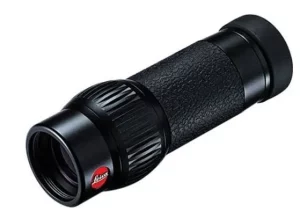
The Leica Monovid 8×20 Monocular is a compact, versatile optical device with amazing clarity and precision. This hunting monocular with reticle is designed for outdoor enthusiasts and professionals. Who demand the highest quality optics in a compact and lightweight package. It features a high-quality 8x magnification that provides a clear and detailed view of distant objects and a 20mm objective lens. That captures bright and vibrant images even in low-light conditions.
The Leica Monovid 8×20 Monocular is built to last, with durable aluminum housing and waterproof and fog-proof construction. That ensures reliable performance in any weather. It also comes with a close-up lens that allows for macro observations . It is also compatible with Leica’s high-quality accessories.
| Pros | Cons |
|---|---|
| ✅ High-quality optics. | ❌ Requires a steady hand to use effectively. |
| ✅ Waterproof and fog proof. | ❌ Expensive. |
| ✅ Compact and lightweight. | ❌ Poor quality of accessories. |
Bushnell Legend Ultra HD Monocular – (Best Monocular For Long Distance)
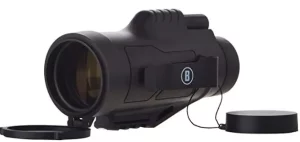
The Bushnell Legend Ultra HD Monocular is a premium-quality optical device with outstanding performance and durability. It features high-quality ED Prime Glass and fully multi-coated optics. They provide crystal-clear images and vibrant colors even in low-light conditions with of 10x magnification and a 42mm objective lens. This monocular offers a wide field of view and exceptional clarity at long distances.
Its rough and durable design includes waterproof and fog-proof housing. That resists the most challenging weather conditions. Additionally, the monocular has a twist-up eyepiece, a comfortable grip, and a textured surface. That provides a secure hold even in wet or slippery conditions.
| Pros | Cons |
|---|---|
| ✅ Easy to Use. | ❌ Difficult to track moving objects |
| ✅ Best for birdwatching, Hiking, and Other outdoor activities. | ❌ Limited magnification. |
| ✅ Durable. | ❌ The belt bag is impractical. |
Vortex Optics Solo Monocular – (Best Military Monocular)
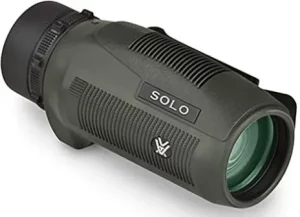
The Vortex Optics Solo Monocular is considered one of the best pocket monoculars due to its compact and versatile design. It offers exceptional clarity and detail with a 10x magnification and a 25mm objective lens. That delivers a clear and bright image even in low-light conditions. It features fully multi-coated lenses that increase light transmission and reduce glare. That provides a high-quality viewing experience.
This monocular is built to withstand harsh weather conditions, with waterproof and fog-proof construction. That ensures reliable performance in any environment. It also features a rubber armor coating that provides a secure grip and protects the monocular from damage due to bumps or drops. This mini monocular is an excellent choice for hikers, birdwatchers, and outdoor enthusiasts. Who wants a high-quality, lightweight, and durable optical device that can easily be carried in a pocket or backpack.
| Pros | Cons |
|---|---|
| ✅ Rugged. | ❌ Difficult to focus on moving objects. |
| ✅ Easy to use. | ❌ Focus ring is a little stif. |
| ✅ Waterproof and fog-proof. | ❌Poor housing design. |
Wingspan Optics Explorer High Powered Monocular – (Best Monocular For Bird Watching)
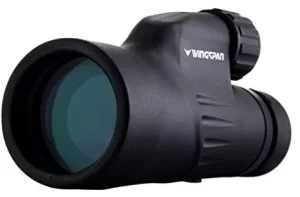
The Wingspan Optics Explorer High Powered Monocular is considered one of the best compact monoculars for birding due to its exceptional optical performance. With a powerful 12x magnification and a 50mm objective lens, this monocular delivers clear, detailed images even at long distances. Its fully multi-coated optics and BaK-4 prism technology ensure bright, sharp photos with minimal distortion. At the same time, its durable construction and waterproof and fog-proof design make it perfect for use in any weather conditions.
The monocular also comes with a smartphone adapter, allowing you to capture and share your observations with others easily. With a comfortable grip and easy-to-use focus knob, the Wingspan Optics Explorer High Powered Monocular is an excellent choice for hikers, birdwatchers, hunters, and outdoor adventurers who demand the best in optical performance and durability. It is also considered one of the best monocular for stargazing due to its powerful magnification and objective lens.
| Pros | Cons |
|---|---|
| ✅ Wide field of view. | ❌ Lens cover prone to falling off. |
| ✅ Comfortable eye relief. | ❌ Limited Accessories. |
| ✅ High magnification. |
Gosky Titan 12X50 High Power Prism Monocular – (Best Monocular For Backpacking)
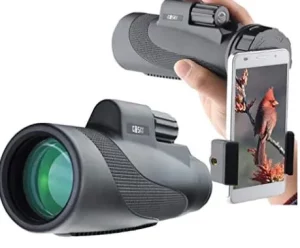
The Gosky Titan 12X50 High Power Prism Monocular is the best monocular for the money and a top-performing optical device that offers excellent magnification and clarity for outdoor enthusiasts. With a 12x magnification and a 50mm objective lens, this birding monocular provides a bright and clear image even in low-light conditions. Its fully multi-coated lenses and BaK-4 prism technology ensure sharp, detailed, and distortion-free images. The monocular is built to withstand harsh outdoor conditions, with a durable and waterproof design that makes it ideal for any weather condition.
It also comes with a smartphone adapter, allowing you to capture and share your observations with others. The Gosky Titan 12X50 High Power Prism Monocular is an excellent choice for hikers, birdwatchers, hunters, and anyone who wants a high-quality, lightweight, easy-to-use monocular that delivers exceptional performance and value for money.
| Pros | Cons |
|---|---|
| ✅ Durable construction. | ❌ Heavy. |
| ✅ High-quality optics. | ❌ No tripod adapter. |
| ✅ All weather monocular. |
Barska Blackhawk Monocular – (Best Monocular For Hunting)
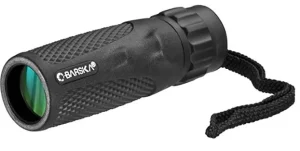
The Barska Blackhawk Monocular is a reliable and durable optical device designed for outdoor enthusiasts and professionals who demand the best visual performance. With a 10x magnification and a 40mm objective lens, this monocular delivers a clear and detailed view of distant objects. Its fully multi-coated lenses and BaK-4 prism technology ensure bright, sharp images with minimal distortion. The Barska Blackhawk Monocular features a rugged and waterproof design that makes it ideal for any weather condition.
It also comes with a handy wrist strap and a carrying case for easy transport and storage. With a comfortable grip and an easy-to-use focus knob, the Barska Blackhawk Monocular is an excellent choice for hikers, birdwatchers, hunters, and anyone who needs a high-quality and reliable monocular at an affordable price.
| Pros | Cons |
|---|---|
| ✅ Good image quality. | ❌ Difficult lens cap removal. |
| ✅ Good value for the price. | ❌ Short focusing distance. |
| ✅ Easy to focus. | ❌ Poor-quality. |
Telescope vs Monocular
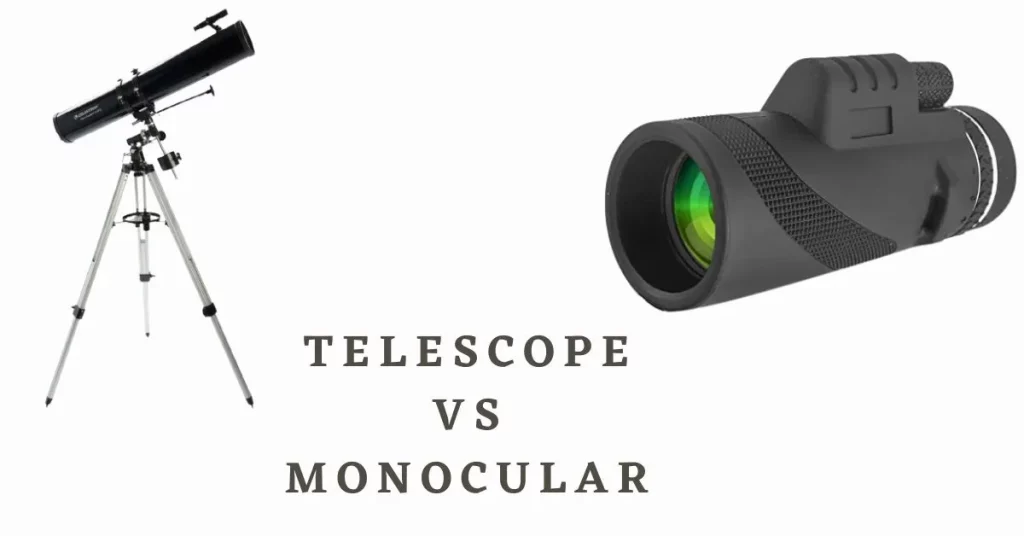
The main difference between a telescope and a monocular is that telescopes are typically more extensive and potent than monoculars. With objective lenses that range from 60mm to 150mm or more. Telescopes are primarily designed for astronomical observation. They can provide much greater magnification and light-gathering capabilities than a monocular. They are usually mounted on a tripod or other stable platform to keep them steady during use.
On the other hand, monoculars are much smaller and more portable than telescopes. They typically have objective lenses ranging from 25mm to 42mm and magnifications of 8x to 10x. Monoculars are ideal for general outdoor observation and can be used for various activities such as hiking, bird watching, and sports events. They are easy to carry in a pocket or backpack and can be used without a tripod.
Another important difference between telescopes and monoculars is their field of view. Telescopes have a narrower field of view, which makes it easier to focus on specific objects but can be limiting when observing large areas. Conversely, monoculars have a wider field of view, making it easier to watch larger areas and track moving objects.
In summary, telescopes are larger, more powerful, and designed primarily for astronomical observation. At the same time, monoculars are smaller, more portable, and ideal for general outdoor statements. When choosing between two, consider your specific needs and the activity you will use them for.
Bonus:
BEST GOPRO CAMERA FOR HIKING AND BACKPACKING BUYING GUIDE
Spotting Scope vs Monocular
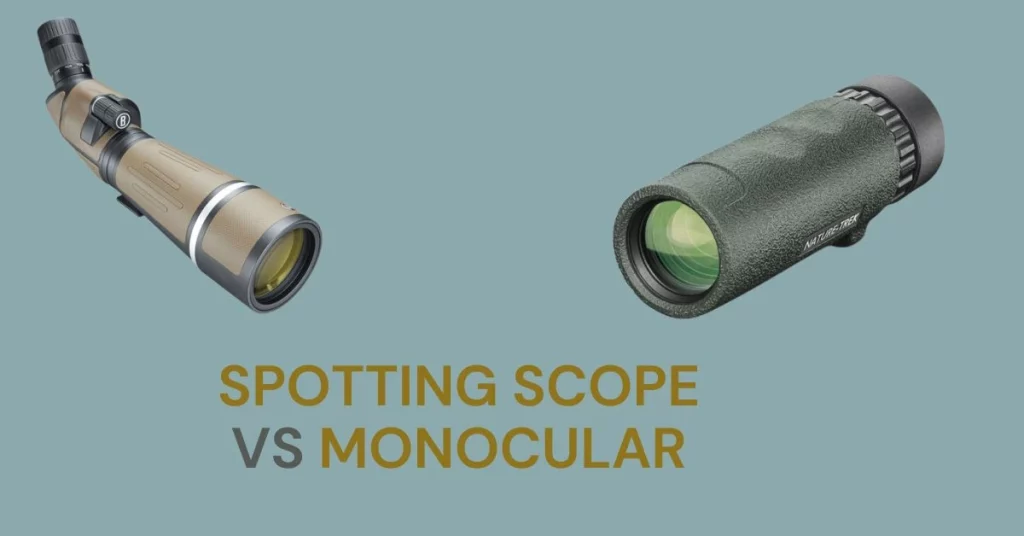
The main difference between Spotting Scope and a Monocular is that spotting scopes are larger and more powerful than Monoculars. They typically have magnifications ranging from 20x to 60x or more and objective lens diameters of 60mm to 100mm or greater. Spotting scopes are often used for birdwatching, hunting, and long-range shooting. They offer better optical clarity and light-gathering capabilities, making them ideal for observing subjects at greater distances.
On the other hand, monoculars are smaller and more compact, making them easier to carry and use while hiking or traveling. They typically have magnifications ranging from 8x to 10x and objective lens diameters of 25mm to 42mm. Monoculars are often used for general outdoor activities such as Hiking, camping, and sightseeing. While they may not offer the same level of magnification and image quality as spotting scopes, they can still produce clear and detailed images of distant objects.
In summary, spotting scopes are larger, more powerful, and offer better image quality than monoculars. They are best suited for specialized activities such as birdwatching, hunting, and long-range shooting. Conversely, monoculars are smaller, more portable, and more versatile, making them an excellent choice for general outdoor activities.
What is a Pocket Telescope?
A pocket telescope is a small, portable telescope designed to be easily carried in a pocket, purse, or backpack. These backpacking telescopes are typically compact, lightweight, and easy to use, making them an ideal option for anyone who wants to observe distant objects while on the go.
Pocket telescopes usually have objective lenses with diameters between 25mm and 35mm, and they typically offer magnifications of 8x to 12x. While less potent than larger telescopes, they can still provide clear and detailed views of the Moon, stars, and other celestial objects.
These hand-held telescopes can be used for various outdoor activities, such as Hiking, camping, and stargazing. They are also famous for birdwatching, sports events, and other types of outdoor observation. Some pocket telescopes come with accessories such as carrying cases, straps, and tripods to make them even more convenient.
Overall, pocket telescopes are an excellent option for anyone who wants to enjoy the wonders of the night sky or observe distant objects while on the go. They are affordable, portable, and easy to use, making them an excellent choice for novice and experienced astronomers.
Monocular Rangefinder
A monocular rangefinder is an optical device that combines the functions of a monocular and a rangefinder. It is commonly used in hunting and golfing to determine the distance between the user and the target.
A monocular rangefinder typically features a laser or GPS technology that accurately measures the distance between the user and the target. It also includes a monocular for viewing the target and surrounding areas. The monocular rangefinder is usually compact and lightweight, making it easy to carry around in a pocket or a bag.
Some benefits of using a monocular rangefinder include increased accuracy in determining the distance to the target, faster and more efficient target acquisition, and improved performance in low-light conditions. It is also popular among outdoor enthusiasts who need a reliable and easy-to-use device for hunting, golfing, and other activities requiring precise distance measurements.
When choosing a monocular rangefinder, consider factors such as the range of the rangefinder, the quality of the optics, and the device’s durability. A good monocular rangefinder should provide accurate distance measurements and clear views of the target, even in adverse weather conditions.
Buying Guide Of Best Monoculars For Hiking
Here’s a buying guide to help you select the best monoculars for Hiking:
- Magnification and Objective Lens Diameter: The first thing to consider is the magnification and objective lens diameter. The magnification will determine how close you can see distant objects.
- Size and Weight: Monoculars are meant to be portable, so size and weight are important factors—the smaller and lighter the monocular, the easier to carry on your hike.
- Durability: Since you will be using the monocular outdoors, choosing one that is durable enough to withstand the rigours of Hiking is essential. Look for a monocular that is waterproof, shockproof, and has a rubber coating to protect against bumps and drops.
- Focus: The focus system should be easy to use and allow quick adjustments to get a clear image. Some monoculars feature a focus ring, while others have a central focus knob.
- Eye Relief: Eye relief is the distance between the eyepiece and your eye. If you wear glasses, look for a monocular with extended eye relief to ensure comfortable use.
- Accessories: Look for a monocular with a carrying case, lens cloth, and neck strap. Some models may also come with a tripod mount or smartphone adapter, which can help capture photos and videos on your hike.
- Price: Monoculars can range from less than $20 to over $500. While it’s alluring to go for the cheapest option, remember that you get what you pay for. A higher-priced monocular typically offers better image quality, durability, and additional features.
By considering these factors, you can find the best monoculars for hiking. A good monocular will enhance your outdoor experience and allow you to see distant objects with clarity and precision.
Conclusion
In conclusion, a monocular can be valuable to any hiker’s gear kit. When selecting the best monoculars for hiking, consider factors such as magnification, objective lens diameter, size and weight, durability, focus, eye relief, accessories, and price. Regardless of which monocular you choose, it should offer clear and precise images, be durable enough to withstand outdoor use, and be portable enough to carry on your hiking adventures. With the right monocular in hand, you can explore the great outdoors with greater ease and enjoyment.
FAQs
Q.1 Can a monocular be used for stargazing?
Ans: While a monocular can be used for stargazing, its limited aperture and magnification may not provide the best viewing experience for celestial objects. A telescope or binoculars may be more suitable.
Q.2 How do I properly care for and maintain my monocular?
Ans: To care for and maintain your monocular, it’s essential to keep it in a protective case when not in use, use a microfiber cloth to clean the lens, avoid touching the lens with your fingers, and store it in a dry place away from moisture or extreme temperatures. Additionally, you should avoid exposing it to harsh chemicals or direct sunlight.
Q.3 What is the most powerful monocular?
Ans: The most potent monocular available on the market varies depending on the manufacturer, but some popular options include the Vortex Optics Viper HD, the Nikon Monarch 5, and the Celestron Nature DX.
Bonus:

